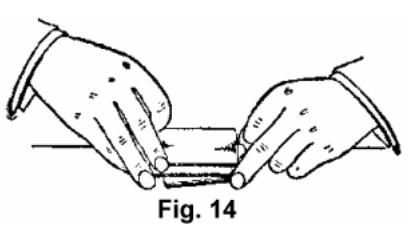Fancy Blind Cuts
THE next blind described is in common use among advantage players, and while it has an excellent appearance to the uninitiated, we consider it far inferior to Cut 3 and Cut 4 as a card table ruse. The principal objection is that, once known as a blind, it can never be worked again, as the action is showy and easily recognized.
To Retain the Complete Stock

SEIZE the deck at sides, near ends, between second finger and thumb of each hand. Draw out about one-third of deck from bottom with right second finger and thumb, and place on top but retain hold. Then hook tip about half of the under part, with the third finger and thumb of right hand, and raise the whole deck from the table with both hands. Now suddenly draw out the middle packet with the right second finger and thumb, the lower packet with the left second finger and thumb, and release the top packet with the right second finger, which will allow it to fall on the table. (See Fig. 14.) Drop the left hand packet on top, and then the right packet.
The hands must be separated rapidly, and with some degree of skill, to allow the top packet to fall fairly on the table, but this is the only hurried movement in the cut. The other two packets are thrown on top carelessly and without haste. A little practice is required to execute the ruse gracefully. It is pretty and well worthy of an effort to acquire. We have elaborated upon this cut, and the following formula for a four throw blind is the outcome:
To Retain the Complete Stock

SEIZE the deck at sides, near ends, between the second finger and thumb of right hand, and the second and third fingers and thumb of left hand. Draw out about one quarter of deck from bottom with right hand and place on top, retaining hold. Then slightly raise about one third of the under packet with the second finger of the left hand, then seize about one-half the remaining lower packet with the third finger of the right hand, holding the last or under portion firmly with the third finger of the left hand. Raise the whole deck from the table and separate both hands suddenly (see Fig. – , letting the upper packet which is released by the right second finger fall on the table. Then drop lower packet in left hand, then packet in right hand, then last packet in left hand, one on the other, and square up.
Some practice is necessary to form the divisions rapidly, and the fingers must take hold of the packets without an instant’s delay. The action of dropping the packets one on the other should be rather slow. The appearance of the cut is brilliant, and the fact that the order of the whole deck remains intact will puzzle more than the unsophisticated.
